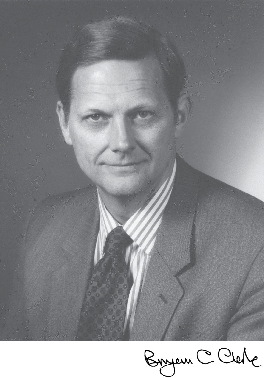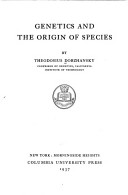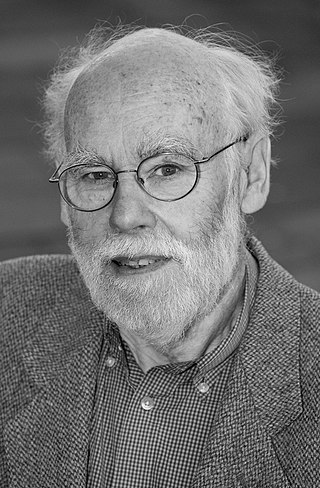Related Research Articles

Evolution is the change in the heritable characteristics of biological populations over successive generations. It occurs when evolutionary processes such as natural selection and genetic drift act on genetic variation, resulting in certain characteristics becoming more or less common within a population over successive generations. The process of evolution has given rise to biodiversity at every level of biological organisation.
Speciation is the evolutionary process by which populations evolve to become distinct species. The biologist Orator F. Cook coined the term in 1906 for cladogenesis, the splitting of lineages, as opposed to anagenesis, phyletic evolution within lineages. Charles Darwin was the first to describe the role of natural selection in speciation in his 1859 book On the Origin of Species. He also identified sexual selection as a likely mechanism, but found it problematic.

The modern synthesis was the early 20th-century synthesis of Charles Darwin's theory of evolution and Gregor Mendel's ideas on heredity into a joint mathematical framework. Julian Huxley coined the term in his 1942 book, Evolution: The Modern Synthesis. The synthesis combined the ideas of natural selection, Mendelian genetics, and population genetics. It also related the broad-scale macroevolution seen by palaeontologists to the small-scale microevolution of local populations.

Evolutionary biology is the subfield of biology that studies the evolutionary processes that produced the diversity of life on Earth. It is also defined as the study of the history of life forms on Earth. Evolution holds that all species are related and gradually change over generations. In a population, the genetic variations affect the phenotypes of an organism. These changes in the phenotypes will be an advantage to some organisms, which will then be passed on to their offspring. Some examples of evolution in species over many generations are the peppered moth and flightless birds. In the 1930s, the discipline of evolutionary biology emerged through what Julian Huxley called the modern synthesis of understanding, from previously unrelated fields of biological research, such as genetics and ecology, systematics, and paleontology.

Bryan Campbell Clarke was a British Professor of genetics, latterly emeritus at the University of Nottingham. Clarke is particularly noted for his work on apostatic selection and other forms of frequency-dependent selection, and work on polymorphism in snails, much of it done during the 1960s. Later, he studied molecular evolution. He made the case for natural selection as an important factor in the maintenance of molecular variation, and in driving evolutionary changes in molecules through time. In doing so, he questioned the over-riding importance of random genetic drift advocated by King, Jukes, and Kimura. With Professor James J Murray Jnr, he carried out an extensive series of studies on speciation in land snails of the genus Partula inhabiting the volcanic islands of the Eastern Pacific. These studies helped illuminate the genetic changes that take place during the origin of species.

Genetics and the Origin of Species is a 1937 book by the Ukrainian-American evolutionary biologist Theodosius Dobzhansky. It is regarded as one of the most important works of modern synthesis and was one of the earliest. The book popularized the work of population genetics to other biologists and influenced their appreciation for the genetic basis of evolution. In his book, Dobzhansky applied the theoretical work of Sewall Wright (1889–1988) to the study of natural populations, allowing him to address evolutionary problems in a novel way during his time. Dobzhansky implements theories of mutation, natural selection, and speciation throughout his book to explain the habits of populations and the resulting effects on their genetic behavior. The book explains evolution in depth as a process over time that accounts for the diversity of all life on Earth. The study of evolution was present, but greatly neglected at the time. Dobzhansky illustrates that evolution regarding the origin and nature of species during this time in history was deemed mysterious, but had expanding potential for progress to be made in its field.

Brian Charlesworth is a British evolutionary biologist at the University of Edinburgh, and editor of Biology Letters. Since 1997, he has been Royal Society Research Professor at the Institute of Evolutionary Biology (IEB) in Edinburgh. He has been married since 1967 to the British evolutionary biologist Deborah Charlesworth.

The European fire-bellied toad is a species of fire-bellied toad native to eastern parts of mainland Europe, where it can be found near waterbodies such as ponds and marshes. It is known for its red colored belly used to ward off predators, an example of aposematism, and its distinctive "whoop" call.

In parapatric speciation, two subpopulations of a species evolve reproductive isolation from one another while continuing to exchange genes. This mode of speciation has three distinguishing characteristics: 1) mating occurs non-randomly, 2) gene flow occurs unequally, and 3) populations exist in either continuous or discontinuous geographic ranges. This distribution pattern may be the result of unequal dispersal, incomplete geographical barriers, or divergent expressions of behavior, among other things. Parapatric speciation predicts that hybrid zones will often exist at the junction between the two populations.
Derek Ernest Gilmor Briggs is an Irish palaeontologist and taphonomist based at Yale University. Briggs is one of three palaeontologists, along with Harry Blackmore Whittington and Simon Conway Morris, who were key in the reinterpretation of the fossils of the Burgess Shale. He is the Yale University G. Evelyn Hutchinson Professor of Geology and Geophysics, Curator of Invertebrate Paleontology at Yale's Peabody Museum of Natural History, and former Director of the Peabody Museum.

Joseph "Joe" Felsenstein is a Professor Emeritus in the Departments of Genome Sciences and Biology at the University of Washington in Seattle. He is best known for his work on phylogenetic inference, and is the author of Inferring Phylogenies, and principal author and distributor of the package of phylogenetic inference programs called PHYLIP. Closely related to his work on phylogenetic inference is his introduction of methods for making statistically independent comparisons using phylogenies.
H. Allen Orr is the Shirley Cox Kearns Professor of Biology at the University of Rochester.
James Mallet is an evolutionary zoologist specialising in entomology.

Jonathan Andrew Eisen is an American evolutionary biologist, currently working at University of California, Davis. His academic research is in the fields of evolutionary biology, genomics and microbiology and he is the academic editor-in-chief of the open access journal PLOS Biology.

Godfrey Matthew Hewitt was a British professor and evolutionary geneticist at the University of East Anglia who was very influential in the development of the fields of molecular ecology, phylogeography, speciation and hybridisation.

Peter D. Keightley FRS is Professor of Evolutionary Genetics at the Institute of Evolutionary Biology in School of Biological Sciences at the University of Edinburgh.
The Extended Evolutionary Synthesis (EES) consists of a set of theoretical concepts argued to be more comprehensive than the earlier modern synthesis of evolutionary biology that took place between 1918 and 1942. The extended evolutionary synthesis was called for in the 1950s by C. H. Waddington, argued for on the basis of punctuated equilibrium by Stephen Jay Gould and Niles Eldredge in the 1980s, and was reconceptualized in 2007 by Massimo Pigliucci and Gerd B. Müller.

The scientific study of speciation — how species evolve to become new species — began around the time of Charles Darwin in the middle of the 19th century. Many naturalists at the time recognized the relationship between biogeography and the evolution of species. The 20th century saw the growth of the field of speciation, with major contributors such as Ernst Mayr researching and documenting species' geographic patterns and relationships. The field grew in prominence with the modern evolutionary synthesis in the early part of that century. Since then, research on speciation has expanded immensely.
Mark A. Kirkpatrick is a theoretical population geneticist and evolutionary biologist. He currently holds the T. S. Painter Centennial Professorship in Genetics in the Department of Integrative Biology at the University of Texas at Austin. His research touches on a wide variety of topics, including the evolution of sex chromosomes, sexual selection, and speciation. Kirkpatrick is the co-author, along with Douglas J. Futuyma, of a popular undergraduate evolution textbook. He is a member of the United States National Academy of Sciences.
Roger Kenneth Butlin is a British evolutionary biologist and professor at the University of Sheffield. He is known for his work on speciation. He served as Editor of Heredity from 2009 to 2012, and President of the Society for the Study of Evolution from 2013 to 2015. In 2015 he received the Darwin Wallace Medal.
References
- 1 2 Nicholas H. Barton, Derek E. G. Briggs, Jonathan A. Eisen, David B. Goldstein, Nipam H. Patel "Evolution" Cold Spring Harbor Laboratory Press; 1st edition (30 June 2007) ISBN 0-87969-684-2
- 1 2 "Curriculum Vitae – Nicholas Hamilton Barton" (PDF). Archived from the original (PDF) on 31 December 2016. Retrieved 8 October 2016.
- ↑ Barton, N. H.; Etheridge, A. M. (2004). "The effect of selection on genealogies". Genetics. 166 (2): 1115–31. doi:10.1534/genetics.166.2.1115. PMC 1470728 . PMID 15020491.

- ↑ Prof. Barton's staff homepage at the University of Edinburgh
- ↑ List of publications
- ↑ Nick Barton's publications indexed by the Scopus bibliographic database. (subscription required)
- ↑ Barton, N. H.; Hewitt, G. M. (1989). "Adaptation, speciation and hybrid zones". Nature. 341 (6242): 497–503. Bibcode:1989Natur.341..497B. doi:10.1038/341497a0. PMID 2677747. S2CID 4360057.
- ↑ Barton, N. H. (2001). "The role of hybridization in evolution". Molecular Ecology. 10 (3): 551–68. doi:10.1046/j.1365-294x.2001.01216.x. PMID 11298968. S2CID 22129817.
- ↑ "National Academy of Sciences Elects Members and International Members". www.nasonline.org. 30 April 2024. Retrieved 12 May 2024.